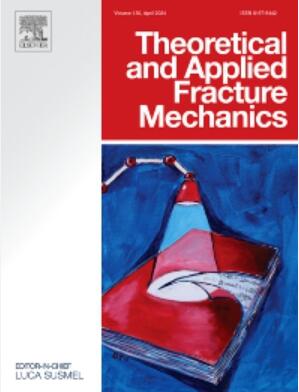拐点原理与数字图像相关和机器学习相结合的疲劳裂纹长度测量方法
IF 5
2区 工程技术
Q1 ENGINEERING, MECHANICAL
引用次数: 0
摘要
目测法是目前广泛应用的一种非接触式疲劳裂纹扩展测量方法,但其检测效率低,需要操作者频繁的输入。数字图像相关(DIC)方法提供了替代方案。然而,全场方法的计算要求很高,而基于线的阈值技术对材料负载条件很敏感,从而降低了一致性。本研究提出并验证了一种新的非接触、基于物理的实时裂纹长度评估方法。由于其基于线的特性,它消除了阈值的需要,并支持更高的测试频率,支持准确、通用和自动化的疲劳测试。该方法将拐点原理与DIC和机器学习相结合。目视检查作为验证基线,使用一种新颖的设置,在样品的同一侧同时应用两种方法进行直接比较。该方法与基线结果吻合良好,平均绝对误差分别为24 μm(静态)和54 μm(动态)。与基于线的阈值设置相比,它的准确性(动态)提高了四倍,并且与负载水平无关,尽管速度慢了1.7倍。本文章由计算机程序翻译,如有差异,请以英文原文为准。
Inflection point principle combined with digital image correlation and machine learning for crack length measurement in fatigue tests
The visual inspection method is a widely used non-contact technique for measuring fatigue crack propagation, but it is inefficient, requiring frequent operator input. Digital image correlation (DIC) methods provide alternatives. However, full-field methods are computationally demanding, while line-based thresholding techniques are sensitive to material load conditions, reducing consistency. This study proposes and validates a new non-contact, physically-based method for real-time crack length evaluation. It eliminates the need for thresholding and enables higher testing frequencies due to its line-based nature, supporting accurate, versatile, and automated fatigue testing. The method integrates the inflection point principle with DIC and machine learning. Visual inspection serves as a validation baseline, using a novel setup that applies both methods simultaneously on the same side of the sample for direct comparison. The proposed method shows good agreement with baseline results, achieving mean absolute errors of 24 μm (static) and 54 μm (dynamic). Compared to line-based thresholding, it is four times more accurate (dynamic) and independent of load levels, though 1.7 times slower.
求助全文
通过发布文献求助,成功后即可免费获取论文全文。
去求助
来源期刊

Theoretical and Applied Fracture Mechanics
工程技术-工程:机械
CiteScore
8.40
自引率
18.90%
发文量
435
审稿时长
37 days
期刊介绍:
Theoretical and Applied Fracture Mechanics'' aims & scopes have been re-designed to cover both the theoretical, applied, and numerical aspects associated with those cracking related phenomena taking place, at a micro-, meso-, and macroscopic level, in materials/components/structures of any kind.
The journal aims to cover the cracking/mechanical behaviour of materials/components/structures in those situations involving both time-independent and time-dependent system of external forces/moments (such as, for instance, quasi-static, impulsive, impact, blasting, creep, contact, and fatigue loading). Since, under the above circumstances, the mechanical behaviour of cracked materials/components/structures is also affected by the environmental conditions, the journal would consider also those theoretical/experimental research works investigating the effect of external variables such as, for instance, the effect of corrosive environments as well as of high/low-temperature.
 求助内容:
求助内容: 应助结果提醒方式:
应助结果提醒方式:


